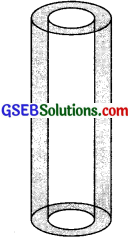Gujarat Board GSEB Solutions Class 9 Maths Chapter 13 Surface Areas and Volumes Ex 13.2 Textbook Questions and Answers.
Gujarat Board Textbook Solutions Class 9 Maths Chapter 13 Surface Areas and Volumes Ex 13.2
Question 1.
The curved surface area of a right circular cylinder of height 14 cm is 88 cm2. Find the diameter of the base of the cylinder.
Solution:
Let the radius of the base of the cylinder be r cm.
h = 14 cm
Curved surface area = 88 cm2
2πrh = 88
= 2 x \(\frac {22}{7}\) x r x 14 = 88
r = \(\frac{88 \times 7}{2 \times 22 \times 14}\)
r = 1 ⇒ 2r = 2
Hence the diameter of the base of the cylinder is 2 cm.
![]()
Question 2.
It is required to make a closed cylindrical tank of height 1 m and a base diameter 140 cm from a metal sheet. How many square meters of the sheet is required for the same?
Solution:
h = 1 m = 100 cm
2r = 140 cm
r = \(\frac {140}{2}\)cm = 70 cm
∴ Total surface area of the closed cylindrical tank
= 2πr(h + r)
= 2 x \(\frac {22}{7}\) x 70 (100 + 70)
= 74800 cm2 = \(\frac {74800}{100 x 100}\) m2 = 7.48 m2
Hence, 7.48 square metres of the sheet are required.
Question 3.
A metal pipe is 77 cm long. The inner diameter of a cross-section is 4 cm, the outer diameter being 4.4 cm. Find its
1. inner curved surface area,
2. outer curved surface area,
3. the total surface area.

Solution:
h = 77 cm
2r = 4 cm
⇒ r = 2 cm
2R = 4.4 cm
⇒ R = 2.2 cm
![]()
1. Inner curved surface area = 2πrh
= 2 x \(\frac {22}{7}\) x 2 x 77 = 968 cm2
2. Outer curved surface area = 2πRh
= 2 x \(\frac {22}{7}\) x 2.2 x 77 = 1064.8 cm2
3. Total surface area
= 2πRh + 2πrh + 2π(R2 – r2)
= 1064.8 + 968 + 2 x \(\frac {22}{7}\) [(2.2)2 – (2)2 ]
= 1064.8 + 968 + 2 x \(\frac {22}{7}\) x (4.84 – 4)
= 1064.8 + 968 + 2 x \(\frac {22}{7}\) x 0.84 7
= 1064.8 + 968 + 5.28 = 2038.08 cm2
Question 4.
The diameter of a roller is 84 cm and its length is 120 cm. It takes 500 complete revolutions to move once over to level a playground. Find the area of the playground in m2.
Solution:
2r = 84 cm
r = 42 cm
h = 120 cm
∴ Area of the playground levelled in taking 1 complete revolution
= 2πrh = 2 x \(\frac {22}{7}\) x 42 x 120
= 31680 cm2
∴ Area of the playground
= 31680 x 500 = 15840000 cm2
= \(\frac{15840000}{100 \times 100}\) m2 = 1584 m2
Hence, the area of the playground is 1584 m2.
![]()
Question 5.
A cylindrical pillar is 50 cm in diameter and 3.5 m in height. Find the cost of painting the curved surface of the pillar at the rate of ₹ 12.50 per m2.
Solution:
2r = 50 cm
∴ r = 25 cm = 0.25 m
h = 3.5 m
∴ Curved surface area of the pillar
= 2πrh = 2 x \(\frac {22}{7}\) x 0.25 x 3.5
= 5.5 m2
∴ Cost of painting the curved surface area of the pillar at the rate of ₹ 12.50 per m2
= ₹ (5.5 x 12.50) = ₹ 68.75
Question 6.
The curved surface area of a right circular cylinder is 4.4 m2. If the radius of the base of the cylinder is 0.7 m, find its height.
Solution:
Let the height of the right circular cylinder be h m.
r = 0.7 m
Curved surface area = 4.4 m2
2πrh = 4.4
2 x \(\frac {22}{7}\) x 0.7 x h = 4.4
4.4h = 4.4 = h = 1m
Hence, the height of the right circular cylinder is 1 m.
![]()
Question 7.
The inner diameter of a circular wall is 3.5 m. It is 10 m deep. Find
1 its inner curved surface area,
2. the cost of plastering this curved surface at the rate of 40 per m2.
Solution:
1. 2r = 3.5 m
r = \(\frac {3.5}{2}\) m
= r = l.75 m
h = 10m
∴ Inner curved surface area of the circular wall = 2πrh
= 2 x \(\frac {22}{7}\) x 1.75 x 10 = 110 m2.
2. Cost of plastering the curved surface at the rate of ₹ 40 per m2
= ₹ (110 x 40) = ₹ 4400
Question 8.
In a hot water heating system, there is a cylindrical pipe of length 28 m and a diameter 5 cm. Find the total radiating surface in the system.
Solution:
h = 28m
2r = 5 cm
r = \(\frac {5}{2}\)cm = x \(\frac {5}{2 x 100}\) m
∴ Total radiating surface in the system
= 2πrh = 2 x \(\frac {22}{7}\) x \(\frac {1}{40}\) x 28
= 4.4 m2
![]()
Question 9.
Find:
1. the lateral or curved surface area of a closed cylindrical petrol storage tank that is 4.2 m in diameter and 4.5 m high.
2. how much steel was actually used, if of the steel actually used was wasted in making the tank.
Solution:
1. 2r = 4.2 m
∴ r = \(\frac {4.2}{2}\) m = 2.1 m
h = 4.5m
∴ Lateral or curved surface area = 2πrh
= 2 x \(\frac {22}{7}\) x 2.1 x 4.5 = 59.4 m2
2. Total surface area = 2πr(h + r)
= 2 x \(\frac {22}{7}\) x 2.1 x (4.5 + 2.1)
= 2 x \(\frac {22}{7}\) x 2.1 x 6.6 = 87.12 m2
Let the actual area of steel used be x m2.
Since \(\frac {1}{12}\) of the actual steel used was wasted, the area of the steel has gone into the tank = \(\frac {11}{12}\) of x.
∴ \(\frac {11}{12}\) x = 87.12
∴ x = \(\frac{87.12 \times 12}{11}\) = 95.04m2
∴ Steel actually used = 95.04 m2.
![]()
Question 10.
In the figure given below, you see the frame of a lampshade. It is to be covered with a decorative cloth. The frame has a base diameter of 20 cm and height of 30 cm. A margin of 2.5 cm is to be given for folding it over the top and bottom of the frame. Find how much cloth is required for covering the lampshade.

Solution:
2r = 20 cm r = 10cm
h = 30cm
∴ Cloth required = 2,tr (h + 2.5 + 2.5)
= 2πr (h + 5)
= 2 x \(\frac {22}{7}\) x 10 x (30+5)
= 2200 cm2
Question 11.
The students of a Vidyalaya were asked to participate in a competition for making and decorating penholders in the shape of a cylinder with a base, using cardboard. Each penholder was to be of radius 3 cm and height 10.5 cm. The Vidyalaya was to supply the competitors with cardboard. If there were 35 competitors, how much cardboard was required to be bought for the competition?
r = 3 cm
h = 10.5 cm
∴ Cardboard required for 1 competitor
= 2πrh + πr2
= 2 x \(\frac {22}{7}\) x 3 x 10.5 + \(\frac {22}{7}\) (3)2
= 198 + \(\frac {198}{7}\) = 198(1+ \(\frac {1}{7}\))
= \(\frac {198 x 8}{7}\) cm2
∴ Cardboard required for 35 competitors
= \(\frac {198 x 8}{7}\) x 35cm2 = 7920 cm2
Hence, 7920 cm2 of cardboard was required to be bought for the competition.
![]()